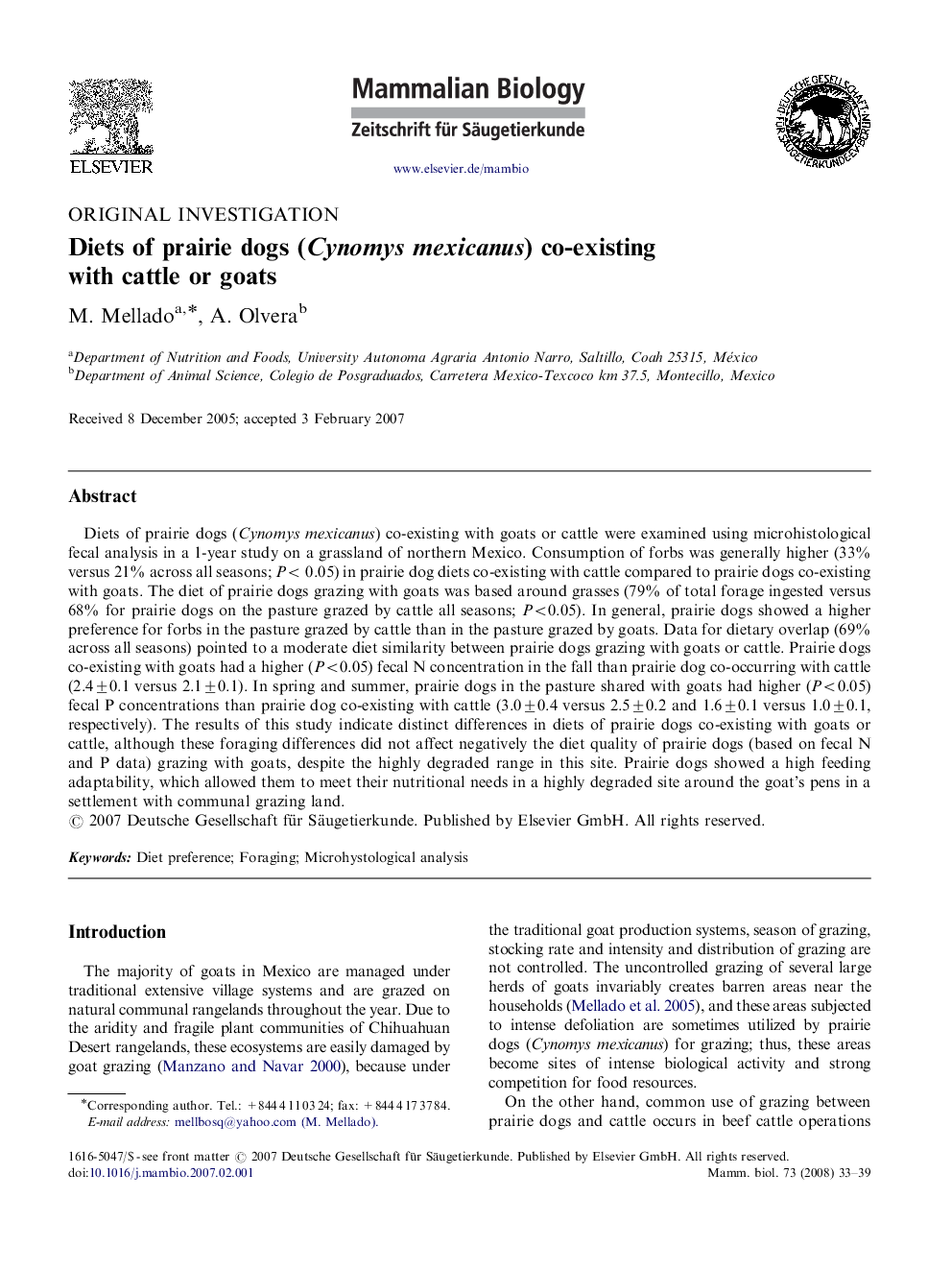| کد مقاله | کد نشریه | سال انتشار | مقاله انگلیسی | نسخه تمام متن |
|---|---|---|---|---|
| 2194321 | 1098431 | 2008 | 7 صفحه PDF | دانلود رایگان |

Diets of prairie dogs (Cynomys mexicanus) co-existing with goats or cattle were examined using microhistological fecal analysis in a 1-year study on a grassland of northern Mexico. Consumption of forbs was generally higher (33% versus 21% across all seasons; P< 0.05) in prairie dog diets co-existing with cattle compared to prairie dogs co-existing with goats. The diet of prairie dogs grazing with goats was based around grasses (79% of total forage ingested versus 68% for prairie dogs on the pasture grazed by cattle all seasons; P<0.05). In general, prairie dogs showed a higher preference for forbs in the pasture grazed by cattle than in the pasture grazed by goats. Data for dietary overlap (69% across all seasons) pointed to a moderate diet similarity between prairie dogs grazing with goats or cattle. Prairie dogs co-existing with goats had a higher (P<0.05) fecal N concentration in the fall than prairie dog co-occurring with cattle (2.4±0.1 versus 2.1±0.1). In spring and summer, prairie dogs in the pasture shared with goats had higher (P<0.05) fecal P concentrations than prairie dog co-existing with cattle (3.0±0.4 versus 2.5±0.2 and 1.6±0.1 versus 1.0±0.1, respectively). The results of this study indicate distinct differences in diets of prairie dogs co-existing with goats or cattle, although these foraging differences did not affect negatively the diet quality of prairie dogs (based on fecal N and P data) grazing with goats, despite the highly degraded range in this site. Prairie dogs showed a high feeding adaptability, which allowed them to meet their nutritional needs in a highly degraded site around the goat's pens in a settlement with communal grazing land.
ZusammenfassungFutterzusammensetzung von Cynomys mexicanus auf Rinder- und Ziegenweiden in NordmexikoDie Futterzusammensetzung von Cynomys mexicanus, die ihr Habitat mit Rindern oder Ziegen teilen, wurde mit Hilfe mikrohistologischer Untersuchung von Kotproben in einer einjährigen Studie bestimmt. C. mexicanus auf Rinderweiden konsumierten mehr Kräuter (33% vs. 21% im Durchschnitt über alle Jahreszeiten, P<0.05) als C. mexicanus auf Ziegenweiden. C. mexicanus auf Ziegenweiden konsumierten hauptsaechlich Gräser (79% des Gesamtkonsums), verglichen mit 68% auf Rinderweiden (Durchschnitt über alle Jahreszeiten, P<0.05). Die Futterzusammensetzung von C. mexicanus auf Rinder- und Ziegenweiden überschnitt sich nur moderat (69% über alle Jahreszeiten). Die fäkale N-Konzentration war höher (P<0.05) in C. mexicanus auf Ziegenweiden verglichen mit C. mexicanus auf Rinderweiden (2.4±0.1 vs. 2.1±0.1%). C. mexicanus auf Ziegenweiden im Frühling und im Sommer hatten höhere (P<0.05) fäkale P-Konzentrationen (3.0±0.1 vs. 2.5±0.2, und 1.6±0.1 vs. 1.0±0.1) als C. mexicanus auf Rinderweiden. Die Ergebnisse zeigen, daß C. mexicanus in der Lage ist, seine Nahrungszusammensetzung der Konkurrenz mit anderen Herbivoren anzupassen. Selbst auf hochgradig degradierten Ziegenweiden war die Qualität der Nahrungszusammensetzung von C. mexicanus nicht beeinträchtigt. C. mexicanus scheint in der Lage, seine Nahrungszusammensetzung extrem flexibel anpassen zu können.
Journal: Mammalian Biology - Zeitschrift für Säugetierkunde - Volume 73, Issue 1, 15 January 2008, Pages 33–39